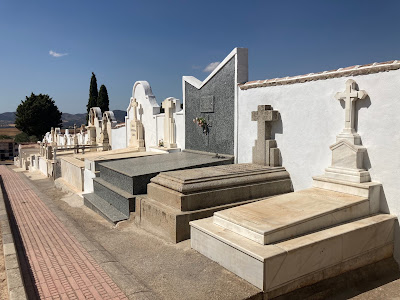
About the Saint George`s Cemetery
Pueblonuevo del Terrible (and then Peñarroya-Pueblonuevo) was an Andalusian mining town founded in the second half of the 19th century because of the discovery of coal and lead mines in the surrounding area. This led to the arrival of foreign companies for the exploitation and transformation of these resources, mostly French. In this underdeveloped and lost place in the south of Spain, an important cultural melting pot was created, made up of people of 7 nationalities: French, Swiss, Russian, Portuguese, Italian, Algerian and Spanish.

Due to the significant population explosion in the town, the original cemetery, which in those days was on the outskirts, became too small and was overtaken by urban growth. This led the local authorities to propose the emptying and closing of the first one and the construction of a new, larger cemetery and further from the urban area. This is how the Saint George`s Cemetery was created in 1908.
The City Council reserved the noblest place in this cemetery for the burial of the foreign population residing in the city, highly qualified and with great purchasing power. The high bourgeoisie of the town, as well as the mayors of the municipality, not only imitated the habits and customs of the foreign technical staff of the company that managed the mines and industries but also chose this space for their burials. So, the French part of the cemetery can explain in a very small space 170 years of history of Peñarroya-Pueblonuevo.
About the French Cemetery

French cemetery of Peñarroya-Pueblonuevo is located on a hill, which confers privileged views of the entire Guadiato Valley, Peñarroya-Pueblonuevo and its old industries, considered a Site of Cultural Interest (National monument).
Most of the tombs and pantheons are made of grey and white marble, as well as sandstone. The carvings are made by local artists except for two of them, whose highly realistic ornamental sets have been carved by important industrial sculptors such as Obdulio Blancas.
From an architectural point of view, French cemetery stands out for its constructive simplicity, presenting floor tombs on both sides of the separating wall in the Central European style and some neo-Gothic pantheons made with black bricks, an abundant material in the area made with coal residue and lime.
Important personalities at the cemetery
Among the most interesting historical figures in the cemetery, we find Baroness Constanza Bich Perrod, first wife of Mario Bich, father of the famous and universal BIC brand pens inventor, Marcel BICH. Marcel lived a large part of his childhood in Peñarroya-Pueblonuevo (from 1915 to 1923), where he contracted malaria, a disease that caused important consequences throughout his life.
Remains of many engineers from the French multinational Societé Minietre et Mètallurgique du Penarroya (SMMP) rest in the cemetery too, as well as relatives of company directors. Camile Desportes, chief electrical engineer of the Pueblonuevo del Terrible thermal power plant and Mariano Galvache, lawyer who reached the highest rank in its company (deputy management), are some examples.
.jpg) In the military field there are two engineers of the SMMP
heroes of the First World War - Louis Henri Eugene and
Victor Menielle Cafiaux.
In the military field there are two engineers of the SMMP
heroes of the First World War - Louis Henri Eugene and
Victor Menielle Cafiaux.
Other important graves and monuments at the cemetery include:
- Mr. Rodríguez Aparicio´s pantheon (mayor of Pueblo Nuevo del Terrible)
- Grave of Mario Bich (father of Marcel Bich, famous BIC ball pen inventor)
- Monolith dedicated to defenders of Democracy during Spanish Civil War (built in 1983)
- Mass graves of Spanish reprisals of Francoism (two mass graves where the remains of 97 people executed by the Franco regime rest)
- Non-Catholic Cemetery (built in 1908 for burial of people who committed suicide, people not married under the Catholic rite and citizens of non-Catholic religions)
Historic significance of the cemetery

Saint George´s Cemetery is considered a
place of democratic memory in Andalusia due to the mass grave of
reprisals from the Franco regime.
The French Cemetery it´s the only French cemetery in southern Spain and the second in Spain, after Mieres one (Asturias). At perimeter walls of the French cemetery, peñarribilian citizens, labour leaders and republican soldiers were shot by the Francoist troops after the fall of Peñarroya-Pueblonuevo during the Spanish Civil War. The common grave, pending opening, is located next to the French cemetery. Furthermore, the French Cemetery offers the opportunity to learn about Spanish history of the 19th and 20th century and about the important colonial footprint left by European industry in the South of Spain.
Rehabilitation of the cemetery
The French Cemetery is an element of local pride. After decades of abandonment, an important rehabilitation project, that has ranked first in the province in all citizen participation initiatives, has started in 2022. French cemetery is promoting citizen participation in the conservation of its funerary heritage. Rehabilitation initiative is being supported by anonymous citizens and companies too and is helping to unite the population.
You can read more about the project HERE.
.jpg)
.jpg)
.jpg)
Address
Saint George`s CemeteryCemetery road,
14200 Peñarroya-Pueblonuevo (Córdoba)
Spain
Contacts
Rubén Cañamaque LópezEmail: caniamaque32@gmail.com
Phone: +34637544156
Website: www.proyectomemoriepenarroya.blogspot.com
Basic data
Managing organization: La Maquinilla AssociationYear of first burial: 1908
Size: 0,5ha
Number of graves: approximately 60
Number of burials: approximately 120
